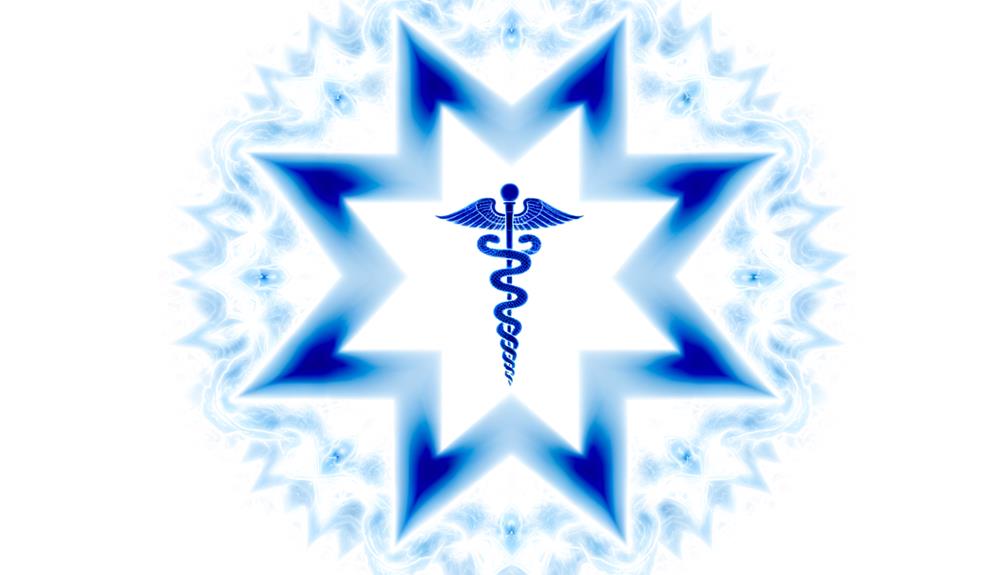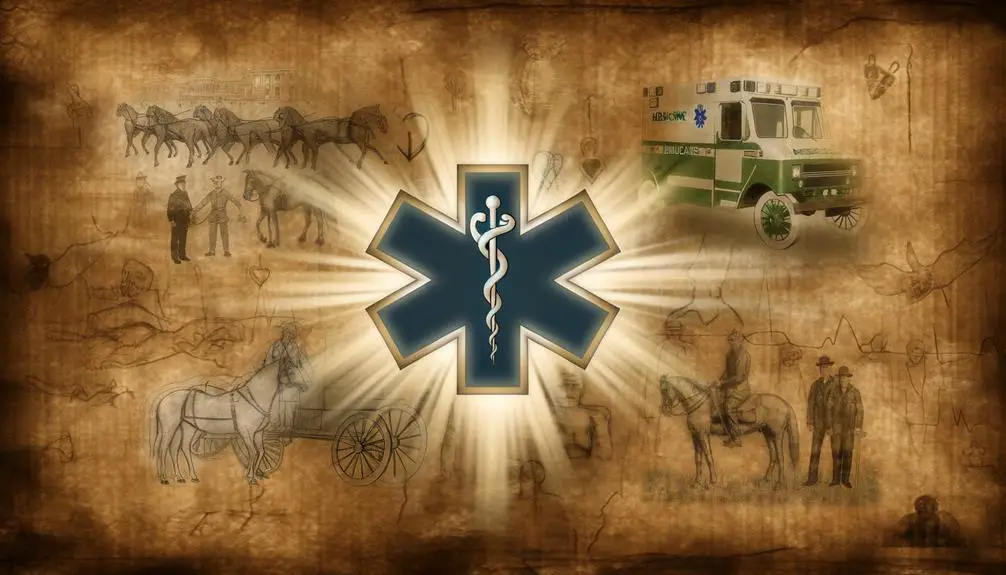What Does the Star of Life Symbol Mean in EMS?
The Star of Life is a globally recognized symbol for emergency medical services. Formed in 1973 by the National Highway Traffic Safety Administration (NHTSA), it features a blue six-pointed star with the Rod of Asclepius at its center.
The six bars represent key functions in emergency medical response, such as detection, reporting, response, on-scene care, care in transit, and transfer to definitive care. The blue color signifies trust and professionalism, while the Rod of Asclepius symbolizes healing and medicine.
It guarantees quick identification of emergency services and embodies the dynamic nature of EMS. Discover more about its design and global impact.

Key Takeaways
- The Star of Life symbolizes trained professionals in emergency medical services and critical care.
- It features a blue six-pointed star with the Rod of Asclepius, symbolizing healing and medicine.
- The six bars represent essential functions in emergency medical response and patient care.
- It ensures quick identification of reliable emergency aid sources globally.
- The symbol reflects trust, professionalism, and advancements in emergency medical services.
History of the Star of Life

The Star of Life, a universally recognized symbol of emergency medical services (EMS), was created in 1973 by the National Highway Traffic Safety Administration (NHTSA).
This emblem was developed to replace the Red Cross on emergency vehicles, which had led to legal conflicts with the American Red Cross organization. Recognizing the need for a unique identifier for EMS personnel and resources, the NHTSA designed the Star of Life to represent the essential and life-saving functions of emergency medical responders.
Since its inception, the symbol has become synonymous with EMS, signifying trained professionals equipped to provide critical care during emergencies. Its adoption has standardized the visual identification of EMS services across the United States and, eventually, worldwide.
Design Elements
Six distinct bars and a central rod of Asclepius characterize the design elements of the Star of Life. Each symbolizing a critical aspect of emergency medical care. The six bars radiate outward from the center, representing the six essential functions performed by EMS professionals.
The rod of Asclepius, an ancient Greek symbol, signifies healing and medicine.
Key design elements include:
- Color: The star is typically blue, symbolizing trust, professionalism, and tranquility.
- Shape: The six bars form a star, indicating unity and all-encompassing care.
- Symbol: The rod of Asclepius in the center highlights the medical and healing nature of the EMS profession.
These elements together create a powerful symbol recognized globally in emergency medical contexts.
Six Bars Explained

The six bars of the Star of Life each represent a critical step in emergency medical services, originating from the need for a universal symbol of EMS reliability.
These bars not only convey the essential stages of patient care but are also imbued with symbolic meanings and specific colors that enhance their significance.
Understanding the medical importance of these elements provides insight into the thorough nature of emergency response protocols.
Origin and Purpose
Emerging from the need for a universally recognized medical emblem, the Star of Life's six bars each represent a critical function in the emergency response continuum. These six functions were designed to standardize and streamline the process of emergency medical services (EMS) worldwide.
Each bar signifies a specific action or phase in the EMS workflow, ensuring thorough care from the moment an incident occurs to the patient's arrival at a medical facility.
- Detection: Identifying the presence of an emergency.
- Reporting: Alerting emergency services to the situation.
- Response: Dispatching appropriate EMS personnel and resources.
This systematic approach guarantees that every emergency is managed efficiently, from initial detection through to the final handover to healthcare professionals, embodying the core purpose of the Star of Life.
Symbolism and Colors
Each bar of the Star of Life is meticulously crafted to represent a specific stage in the emergency medical services process, with distinct colors symbolizing different aspects of care.
The six bars stand for Detection, Reporting, Response, On-Scene Care, Care in Transit, and Transfer to Definitive Care.
Blue, the primary color of the Star of Life, symbolizes trust, professionalism, and the serenity that emergency responders bring to critical situations.
The intertwining of these stages and colors offers a thorough visual representation of the systematic approach to emergency medical services.
This structured symbolism guarantees that each step of the process is acknowledged and respected, reflecting the complexity and precision inherent in emergency medical care.
Medical Significance
How do the six bars of the Star of Life encapsulate the meticulous stages of emergency medical care? Each bar represents a critical step in the continuum of emergency medical services, from the moment of incident to the transfer to definitive care.
These stages are:
- Detection: The identification of an emergency situation.
- Reporting: Communicating the occurrence of the emergency.
- Response: Dispatching appropriate emergency personnel and equipment.
Following these initial steps, the symbol continues with:
- On-Scene Care: Providing immediate medical intervention.
- Care in Transit: Maintaining patient stability during transport.
- Transfer to Definitive Care: Ensuring the patient reaches appropriate medical facilities.
Each stage is essential, forming a thorough framework for effective emergency medical response.
Rod of Asclepius
The Rod of Asclepius, a prominent symbol in medicine, features a single serpent entwined around a staff. This emblem is rooted in Greek mythology, representing Asclepius, the deity associated with healing and medicinal arts.
The serpent signifies rejuvenation and renewal, as it sheds its skin, while the staff symbolizes authority and steadfastness. Historically adopted by the medical profession, the Rod of Asclepius underscores the enduring commitment to healing and medical ethics.
Its usage spans various medical organizations and institutions globally, maintaining its importance as a universal emblem of healthcare. Understanding this symbol is essential for appreciating its role in conveying medical responsibility and the perpetual pursuit of health and well-being.
Symbol in EMS

The Star of Life holds significant importance within Emergency Medical Services (EMS), embodying both historical and contemporary elements.
Each point of the six-pointed star represents a critical function in the EMS response process.
The evolution of this symbol highlights its enduring relevance and adaptability in representing emergency medical care.
Historical Origin
Originating in the early 1970s, the Star of Life symbol was developed by the National Highway Traffic Safety Administration (NHTSA) to identify emergency medical services. This emblem was created to provide a uniform symbol that could be easily recognized by the public and professionals alike, signifying the presence of trained emergency medical personnel. The need for a standardized symbol arose due to the increasing importance of pre-hospital care in improving patient outcomes.
Key historical points include:
- 1973: The symbol was officially adopted by NHTSA.
- Design Inspiration: Derived from the medical symbol of the caduceus.
- Global Adoption: Widely recognized in many countries beyond the United States.
The Star of Life remains an essential identifier in emergency medical services globally.
Six-Pointed Star Significance
Integral to its design, the six-pointed Star of Life symbol holds specific significance within Emergency Medical Services (EMS), each point representing a critical aspect of patient care.
These six points are:
- Detection,
- Reporting,
- Response,
- On-Scene Care,
- Care in Transit, and
- Transfer to Definitive Care.
Together, they encapsulate the inclusive process of emergency medical intervention, from initial recognition of a medical emergency to the final handover at a medical facility.
This structured representation underscores the coordinated effort essential in EMS, emphasizing timely and effective response.
The Star of Life not only serves as a symbol of EMS but also as a reminder of the systematic and lifesaving steps involved in emergency medical care.
EMS Symbol Evolution
Frequently evolving over the decades, the EMS symbol has undergone significant transformations to better represent the advancing field of emergency medical services. Initially, EMS relied on the Red Cross symbol, but as the field expanded, a distinct and universally recognized emblem became necessary.
The 'Star of Life,' introduced by the National Highway Traffic Safety Administration (NHTSA) in 1973, embodies this need for a unique identifier.
Key milestones in the EMS symbol evolution include:
- 1973: Introduction of the 'Star of Life' by NHTSA.
- 1980s: Standardization of the symbol's use on ambulances and emergency equipment.
- 2000s: Digital adaptation for use in electronic health records and telemedicine platforms.
These changes reflect the dynamic nature of EMS and its commitment to clarity and efficiency.
Global Recognition
The Star of Life symbol is acknowledged globally as an emblem of emergency medical services and healthcare professionals. Originating in the United States, it has transcended borders to become a universal mark of medical assistance.
Featuring a blue six-pointed star with the Rod of Asclepius at its center, this symbol is prominently displayed on emergency vehicles, uniforms, and medical facilities. Its widespread recognition ensures that individuals in need of urgent care can quickly identify reliable sources of aid, regardless of their location.
The symbol's universal adoption underscores the collaborative efforts of international health organizations to standardize emergency response protocols, ultimately enhancing the efficiency and effectiveness of medical services worldwide.
Conclusion
The Star of Life is a symbol steeped in historical significance and intricate design elements. It holds profound meaning within the world of emergency medical services. Each of its six bars represents a critical step in patient care, culminating in the Rod of Asclepius, an emblem of healing.
As this symbol continues to achieve global recognition, its impact on emergency medical systems worldwide underscores its enduring importance. Yet, its full potential in unifying and enhancing global EMS remains to be fully realized.






